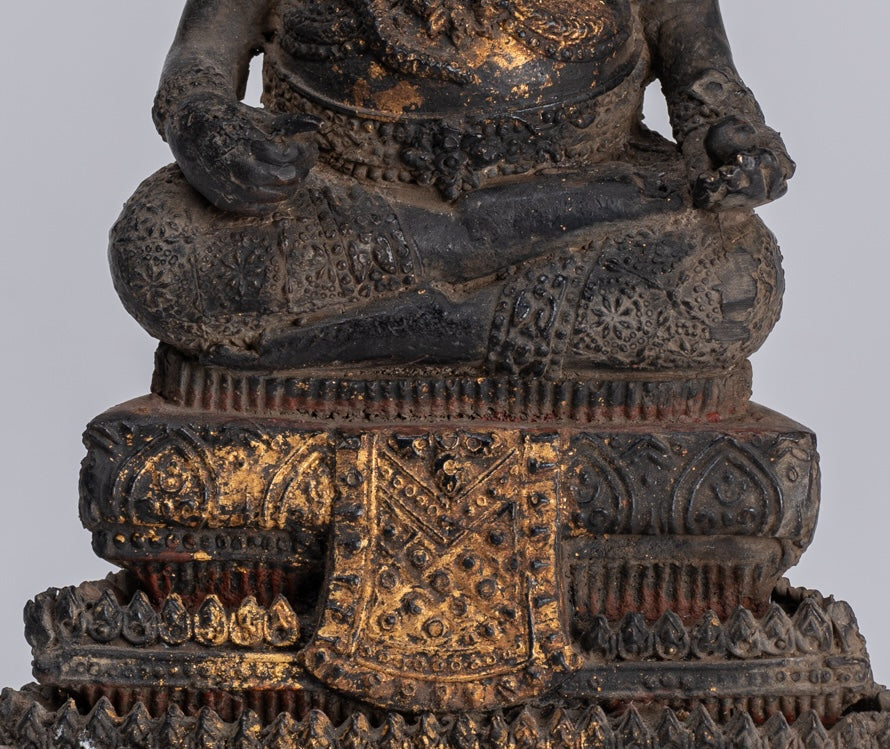-
Ganesha Statue - Antique Thai Style Bronze Seated Rattanakosin Ganesha Statue - 19cm/8"
Measures Height) 19cm/8"
Antique Rattanakosin style bronze seated Ganesha from Thailand.
Ganesha is seated upon a decorated throne in the distinctive style of the Rattanakosin period.
Ganesha is the elephant headed son of Shiva. He holds the remnants of his broken tusk in his hand. The breaking of the tusk has several backstories. One instance suggests that it was shattered when Shiva cut the head off the elephant, prior to bestowing it onto Ganesha. Another writes that Ganesha's quill broke and he needed a writing instrument, try telling your boss that next time you try to write up a report with an elephant tusk because your computer crashed.
Regardless of its multiple origins, the holding of the tusk represents less of a keepsake, and more of a depiction that our spirituality is more important than our outer bodies, meaning we must overcome the duality of the two as separate entities.
In his other hand Ganesha holds a bowl of laddus, the name for Indian sweetmeats.
Whilst some may interpret this as Ganesha simply having a sweet tooth or a (relatable) penchant for candy, it is no surprise that the sweet delicacies carry further meaning. These tasty treats represent the reward for a wisely-led life and the eternal sweetness that comes from a fulfilled experience. Dentists around the world will be delighted to hear that Ganesha is never depicted actually eating the sweetmeats, but this item of the deity does also show his parallels with everyday human life. This relates to Ganesha's status as a Vedic God, which means he does not forget even those who are not his devotees and instead looks out for everyone. This is communicated through his depiction as always looking upwards or at eye-level, as he is surveying all human life and is therefore not solely focussed on those praying to him.
The direction of Ganesha's trunk has symbolic meaning. Here the trunk turns to Ganesha's left. This signifies the direction for success in the world. It is a position associated with grihastas, or householders.
In his early forms in India, Ganesha was associated with fertility. Later he became widely revered as the Remover of Obstacles and more generally as Lord of Beginnings and Lord of Obstacles, patron of arts and sciences and the deity of intellect and wisdom.
One of the most recognizable of the Asian deities this representation of Ganesha is sure to enlighten your home with endlessly timeless style.
SATISFACTION GUARANTEE - We have been offering SE Asian Art for many years and are proud of the reputation we have developed for fair and honest listings. However, if for any reason, whatsoever, you are unhappy with your purchase please just let us know and we will provide a full refund. We want you to be 100% happy with your purchase.
-
The majority of orders will be shipped with DHL. This is a secure, express and fully tracked service.
Items less than 2Kg we typically ship using Royal Mail.
Once we receive your order we try to ship all orders the same or next working day.
Large and/or fragile pieces requiring palletising, specialist crating and/or extra packaging may take a little longer. Palletised shipments will be delivered curbside.
All orders over 35 GBP will be shipped free of charge.

-
We genuinely hope that all purchases delight.
However, if they do not, regardless of reason, we will refund all orders upon receipt of the unwanted item. Just notify us within 14 days of receiving your order that you wish to make a return and send the piece back to us with 30 days of delivery.
Let Us Help You Find The Piece You Desire
Let Us Help You Find The Piece You Desire
They arrived yesterday safe and sound and are gorgeous! Thank you!
Juliann, San Diego, CA, USA
We received our package. They are beautiful pieces of art. I bought them as gifts for my children. Thank you
Sri, Philadelphia, PA, USA
Received the Naga statue today, many thanks all good :-)
John, Southport, UK






































